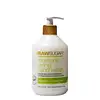What's inside
What's inside
 Benefits
Benefits

 Concerns
Concerns

 Ingredients Side-by-side
Ingredients Side-by-side

Water
Skin ConditioningCocamidopropyl Betaine
CleansingSodium C14-16 Olefin Sulfonate
CleansingSodium Cocoamphoacetate
CleansingSodium Cocoyl Glutamate
CleansingSodium Lauryl Glucose Carboxylate
CleansingLauryl Glucoside
CleansingGlycerin
HumectantButyrospermum Parkii Butter Extract
Skin ConditioningAloe Barbadensis Leaf Juice
Skin ConditioningOlea Europaea Fruit Oil
MaskingLimnanthes Alba Seed Oil
Skin ConditioningSimmondsia Chinensis Seed Oil
EmollientPersea Gratissima Fruit Extract
EmollientCereus Grandiflorus Flower Extract
Skin ConditioningPyrus Communis Fruit Extract
Skin ConditioningSymphytum Officinale Leaf Extract
Skin ConditioningDecyl Glucoside
CleansingSodium Lauroyl Sarcosinate
CleansingPEG-150 Distearate
EmulsifyingGuar Hydroxypropyltrimonium Chloride
Skin ConditioningPolyquaternium-7
Hydroxypropyl Guar
Emulsion StabilisingCetearyl Alcohol
EmollientPhenoxyethanol
PreservativeDehydroacetic Acid
PreservativeBenzyl Alcohol
PerfumingCitric Acid
BufferingParfum
MaskingWater, Cocamidopropyl Betaine, Sodium C14-16 Olefin Sulfonate, Sodium Cocoamphoacetate, Sodium Cocoyl Glutamate, Sodium Lauryl Glucose Carboxylate, Lauryl Glucoside, Glycerin, Butyrospermum Parkii Butter Extract, Aloe Barbadensis Leaf Juice, Olea Europaea Fruit Oil, Limnanthes Alba Seed Oil, Simmondsia Chinensis Seed Oil, Persea Gratissima Fruit Extract, Cereus Grandiflorus Flower Extract, Pyrus Communis Fruit Extract, Symphytum Officinale Leaf Extract, Decyl Glucoside, Sodium Lauroyl Sarcosinate, PEG-150 Distearate, Guar Hydroxypropyltrimonium Chloride, Polyquaternium-7, Hydroxypropyl Guar, Cetearyl Alcohol, Phenoxyethanol, Dehydroacetic Acid, Benzyl Alcohol, Citric Acid, Parfum
Ingredients Explained
These ingredients are found in both products.
Ingredients higher up in an ingredient list are typically present in a larger amount.
Citric Acid is an alpha hydroxy acid (AHA) naturally found in citrus fruits like oranges, lemons, and limes.
Like other AHAs, citric acid can exfoliate skin by breaking down the bonds that hold dead skin cells together. This helps reveal smoother and brighter skin underneath.
However, this exfoliating effect only happens at high concentrations (20%) which can be hard to find in cosmetic products.
Due to this, citric acid is usually included in small amounts as a pH adjuster. This helps keep products slightly more acidic and compatible with skin's natural pH.
In skincare formulas, citric acid can:
While it can provide some skin benefits, research shows lactic acid and glycolic acid are generally more effective and less irritating exfoliants.
Most citric acid used in skincare today is made by fermenting sugars (usually from molasses). This synthetic version is identical to the natural citrus form but easier to stabilize and use in formulations.
Read more about some other popular AHA's here:
Learn more about Citric AcidDecyl Glucoside is a glucose-based surfactant and emulsion stabilizer. It is created by reacting glucose with the fatty acids from plants.
Surfactants help clean the skin by trapping oil, sebum, and dirt to be washed away. As an emulsion stabilizer, it stabilizes the ingredients in a product by preventing them from separating.
This ingredient is biodegradable and non-toxic. This ingredient is commonly found in baby shampoos.
Decyl Glucoside is sometimes used to stabilize the UV filter Tinosorb.
Learn more about Decyl GlucosideGlycerin is already naturally found in your skin. It helps moisturize and protect your skin.
A study from 2016 found glycerin to be more effective as a humectant than AHAs and hyaluronic acid.
As a humectant, it helps the skin stay hydrated by pulling moisture to your skin. The low molecular weight of glycerin allows it to pull moisture into the deeper layers of your skin.
Hydrated skin improves your skin barrier; Your skin barrier helps protect against irritants and bacteria.
Glycerin has also been found to have antimicrobial and antiviral properties. Due to these properties, glycerin is often used in wound and burn treatments.
In cosmetics, glycerin is usually derived from plants such as soybean or palm. However, it can also be sourced from animals, such as tallow or animal fat.
This ingredient is organic, colorless, odorless, and non-toxic.
Glycerin is the name for this ingredient in American English. British English uses Glycerol/Glycerine.
Learn more about GlycerinPhenoxyethanol is a preservative that has germicide, antimicrobial, and aromatic properties. Studies show that phenoxyethanol can prevent microbial growth. By itself, it has a scent that is similar to that of a rose.
It's often used in formulations along with Caprylyl Glycol to preserve the shelf life of products.
Water. It's the most common cosmetic ingredient of all. You'll usually see it at the top of ingredient lists, meaning that it makes up the largest part of the product.
So why is it so popular? Water most often acts as a solvent - this means that it helps dissolve other ingredients into the formulation.
You'll also recognize water as that liquid we all need to stay alive. If you see this, drink a glass of water. Stay hydrated!
Learn more about Water